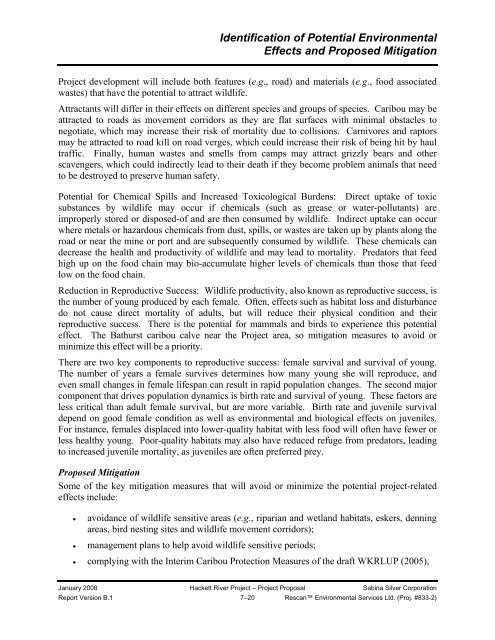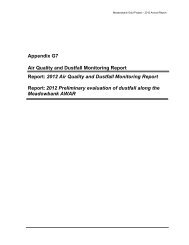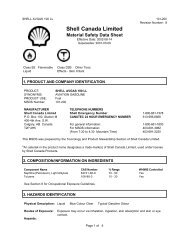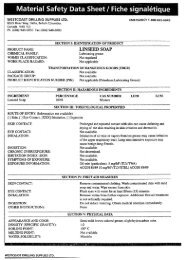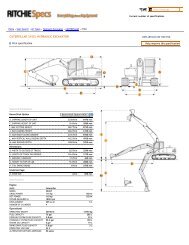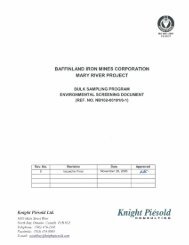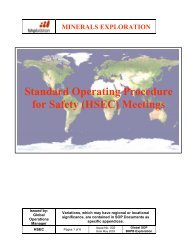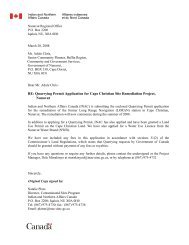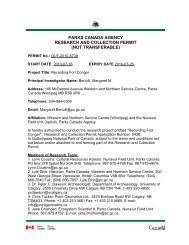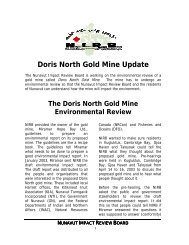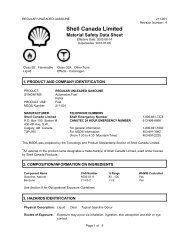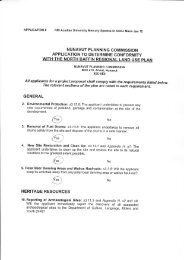080121-08MN006-Sabina Hackett River Project Proposal ... - NIRB
080121-08MN006-Sabina Hackett River Project Proposal ... - NIRB
080121-08MN006-Sabina Hackett River Project Proposal ... - NIRB
You also want an ePaper? Increase the reach of your titles
YUMPU automatically turns print PDFs into web optimized ePapers that Google loves.
Identification of Potential EnvironmentalEffects and Proposed Mitigation<strong>Project</strong> development will include both features (e.g., road) and materials (e.g., food associatedwastes) that have the potential to attract wildlife.Attractants will differ in their effects on different species and groups of species. Caribou may beattracted to roads as movement corridors as they are flat surfaces with minimal obstacles tonegotiate, which may increase their risk of mortality due to collisions. Carnivores and raptorsmay be attracted to road kill on road verges, which could increase their risk of being hit by haultraffic. Finally, human wastes and smells from camps may attract grizzly bears and otherscavengers, which could indirectly lead to their death if they become problem animals that needto be destroyed to preserve human safety.Potential for Chemical Spills and Increased Toxicological Burdens: Direct uptake of toxicsubstances by wildlife may occur if chemicals (such as grease or water-pollutants) areimproperly stored or disposed-of and are then consumed by wildlife. Indirect uptake can occurwhere metals or hazardous chemicals from dust, spills, or wastes are taken up by plants along theroad or near the mine or port and are subsequently consumed by wildlife. These chemicals candecrease the health and productivity of wildlife and may lead to mortality. Predators that feedhigh up on the food chain may bio-accumulate higher levels of chemicals than those that feedlow on the food chain.Reduction in Reproductive Success: Wildlife productivity, also known as reproductive success, isthe number of young produced by each female. Often, effects such as habitat loss and disturbancedo not cause direct mortality of adults, but will reduce their physical condition and theirreproductive success. There is the potential for mammals and birds to experience this potentialeffect. The Bathurst caribou calve near the <strong>Project</strong> area, so mitigation measures to avoid orminimize this effect will be a priority.There are two key components to reproductive success: female survival and survival of young.The number of years a female survives determines how many young she will reproduce, andeven small changes in female lifespan can result in rapid population changes. The second majorcomponent that drives population dynamics is birth rate and survival of young. These factors areless critical than adult female survival, but are more variable. Birth rate and juvenile survivaldepend on good female condition as well as environmental and biological effects on juveniles.For instance, females displaced into lower-quality habitat with less food will often have fewer orless healthy young. Poor-quality habitats may also have reduced refuge from predators, leadingto increased juvenile mortality, as juveniles are often preferred prey.Proposed MitigationSome of the key mitigation measures that will avoid or minimize the potential project-relatedeffects include:• avoidance of wildlife sensitive areas (e.g., riparian and wetland habitats, eskers, denningareas, bird nesting sites and wildlife movement corridors);• management plans to help avoid wildlife sensitive periods;• complying with the Interim Caribou Protection Measures of the draft WKRLUP (2005),January 2008 <strong>Hackett</strong> <strong>River</strong> <strong>Project</strong> – <strong>Project</strong> <strong>Proposal</strong> <strong>Sabina</strong> Silver CorporationReport Version B.1 7–20 Rescan Environmental Services Ltd. (Proj. #833-2)


